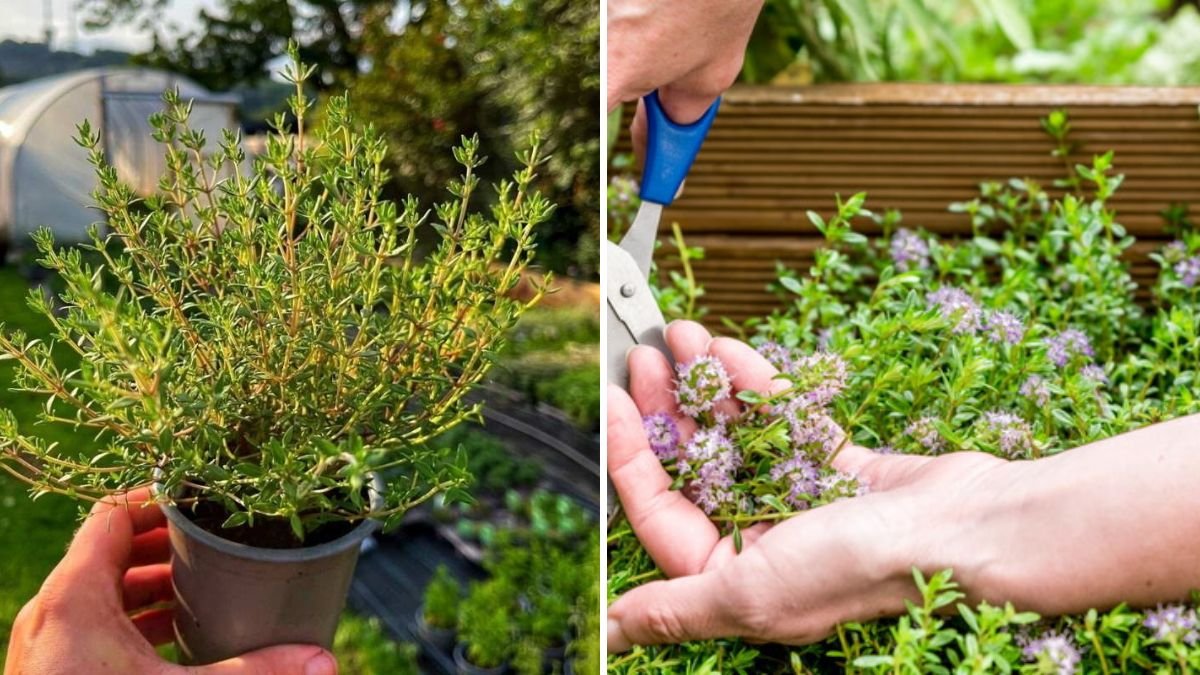Thyme (Thymus vulgaris) is a beloved herb in kitchens around the world, prized for its earthy, slightly minty aroma and versatile flavor. It enhances a wide range of dishes, from roasted vegetables and meats to soups, sauces, and even herbal teas. While growing thyme is relatively easy, the timing of harvest plays a critical role in ensuring maximum aroma and flavor. Harvest it too early or too late, and you risk losing the essential oils that give thyme its distinctive taste.
This guide explores the best time to harvest thyme, how to identify peak aroma, and proper techniques to maintain a healthy plant while maximizing flavor.
1. Understanding Thyme Growth
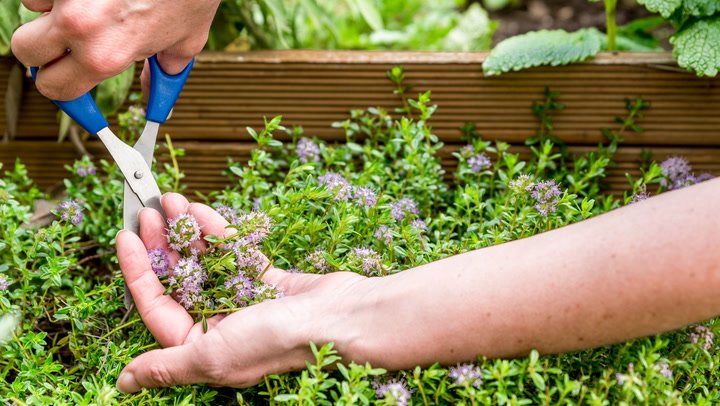
Before harvesting, it’s important to understand how thyme grows:
- Perennial nature: Thyme is a perennial herb, meaning it can produce leaves year after year if cared for properly.
- Woody stems: Mature thyme develops woody stems at the base while new, tender growth emerges at the tips.
- Leaf structure: Tiny, aromatic leaves grow densely along the stems. These are the parts used for culinary and medicinal purposes.
- Flowering: Thyme produces small, tubular flowers that attract pollinators and eventually set seeds. Flowering can influence the intensity of aroma in leaves.
Knowing the plant’s growth habits helps in determining the ideal harvesting period.
2. Why Timing Matters
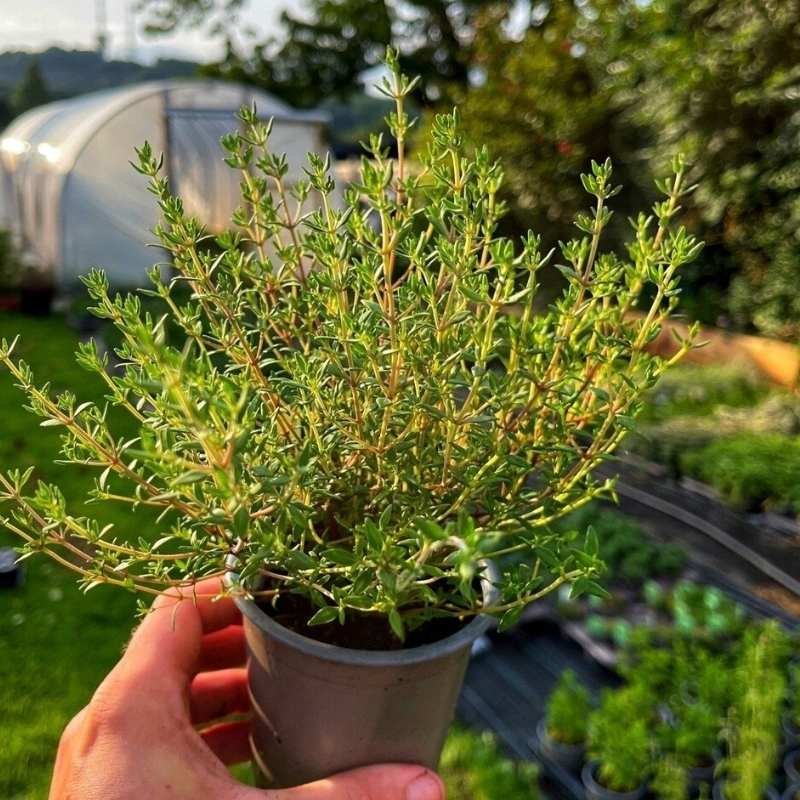
Thyme’s flavor comes primarily from its essential oils, concentrated in the leaves and stems. The timing of harvest affects:
- Aroma: Essential oil concentration peaks at specific growth stages.
- Flavor: Young, tender leaves have a milder taste, while older leaves are more pungent.
- Plant health: Improper harvesting can stress the plant or reduce long-term productivity.
Harvesting at the right time ensures maximum aromatic impact for cooking and preserves the plant’s vigor.
3. Ideal Time of Year to Harvest Thyme
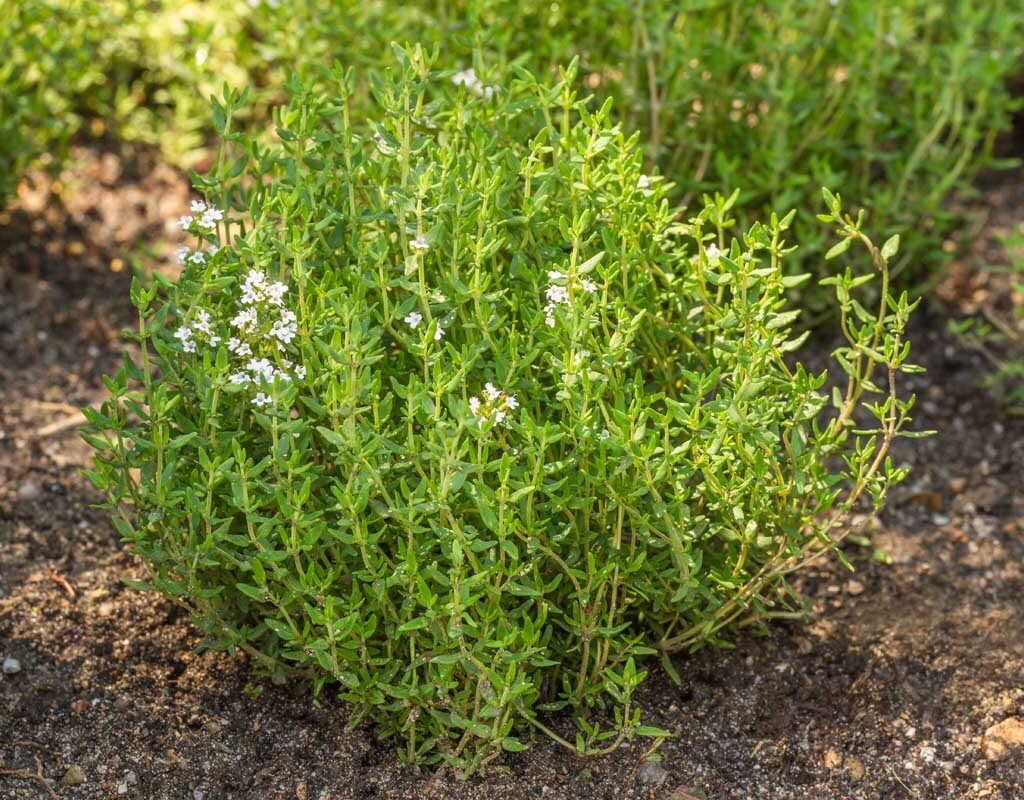
- Spring and early summer: The best time to harvest thyme for maximum aroma is just before the plant flowers. This is when essential oil levels are highest, giving leaves their robust scent and flavor.
- Late summer and fall: Leaves can still be harvested, but aroma may be slightly reduced, and older, woody stems may dominate.
- Winter: If grown indoors or in mild climates, thyme can be harvested year-round, though flavor is often milder in dormant periods.
Tip: Avoid harvesting thyme immediately after rainfall, as wet leaves may dilute essential oils and make drying for storage less effective.
4. Daily and Seasonal Timing
- Time of day: The best time to harvest thyme is mid-morning, after dew has dried but before the day’s heat causes the plant to stress. Essential oils are at their peak during this period.
- Seasonal cues: Monitor for new growth just before flowering; these stems are ideal for harvest.
Timing both seasonally and daily ensures leaves have maximum fragrance and flavor.
5. Selecting the Right Stems
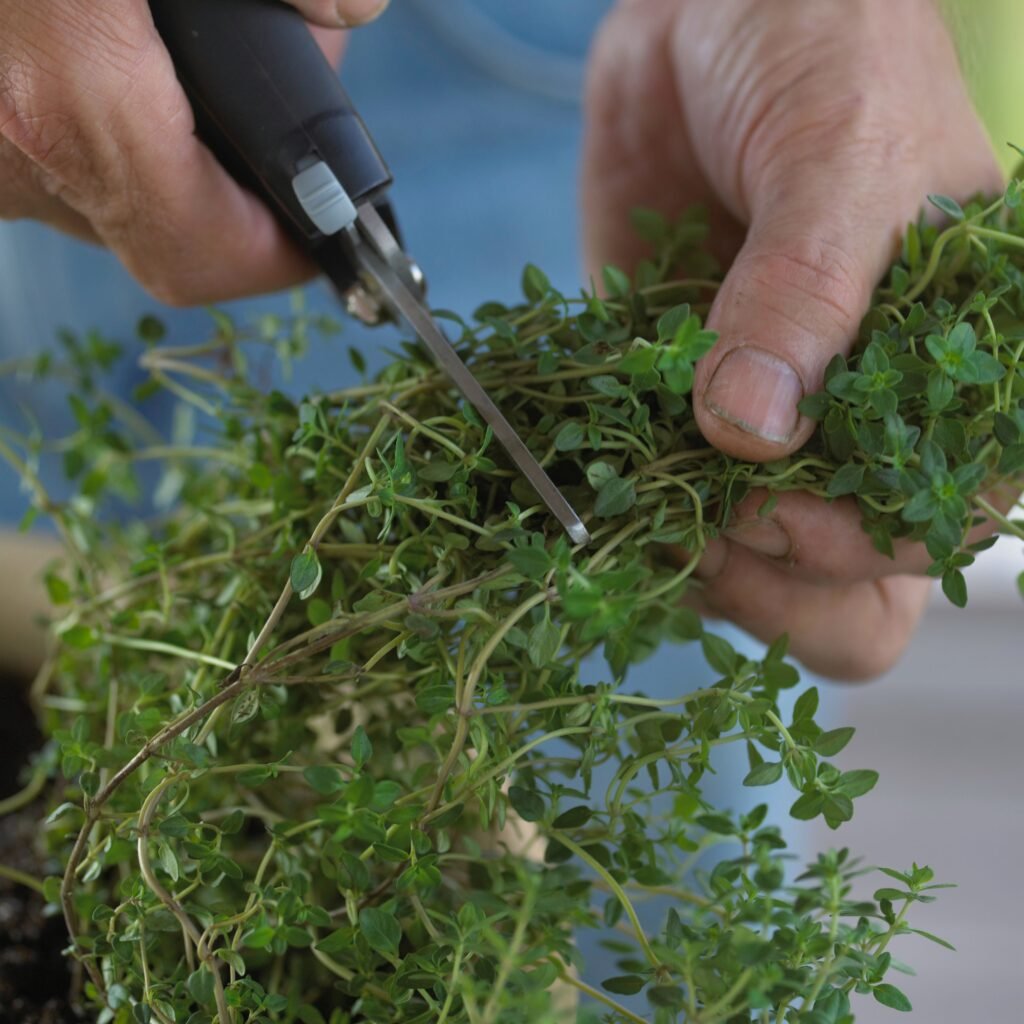
- Choose healthy, tender stems from the top of the plant.
- Avoid old, woody stems at the base, which have less flavor and tougher leaves.
- Remove any damaged or yellowing leaves to maintain plant health.
Tip: Harvesting only the top 5–6 inches encourages bushier growth and prevents the plant from becoming sparse.
6. Harvesting Techniques
Proper harvesting techniques protect the plant and maximize aroma:
6.1 Pinching
- Use fingers to pinch off stems at the desired length.
- Pinching stimulates lateral growth, resulting in a fuller, more productive plant.
6.2 Snipping
- Use sharp scissors or pruning shears to cut stems cleanly just above a leaf node.
- Avoid crushing stems, which can damage leaves and reduce essential oil content.
6.3 Partial Harvesting
- Never harvest more than one-third of the plant at a time, allowing the plant to recover.
- Focus on selective harvesting of aromatic tips while leaving older stems to continue producing new growth.
7. Harvesting for Fresh Use
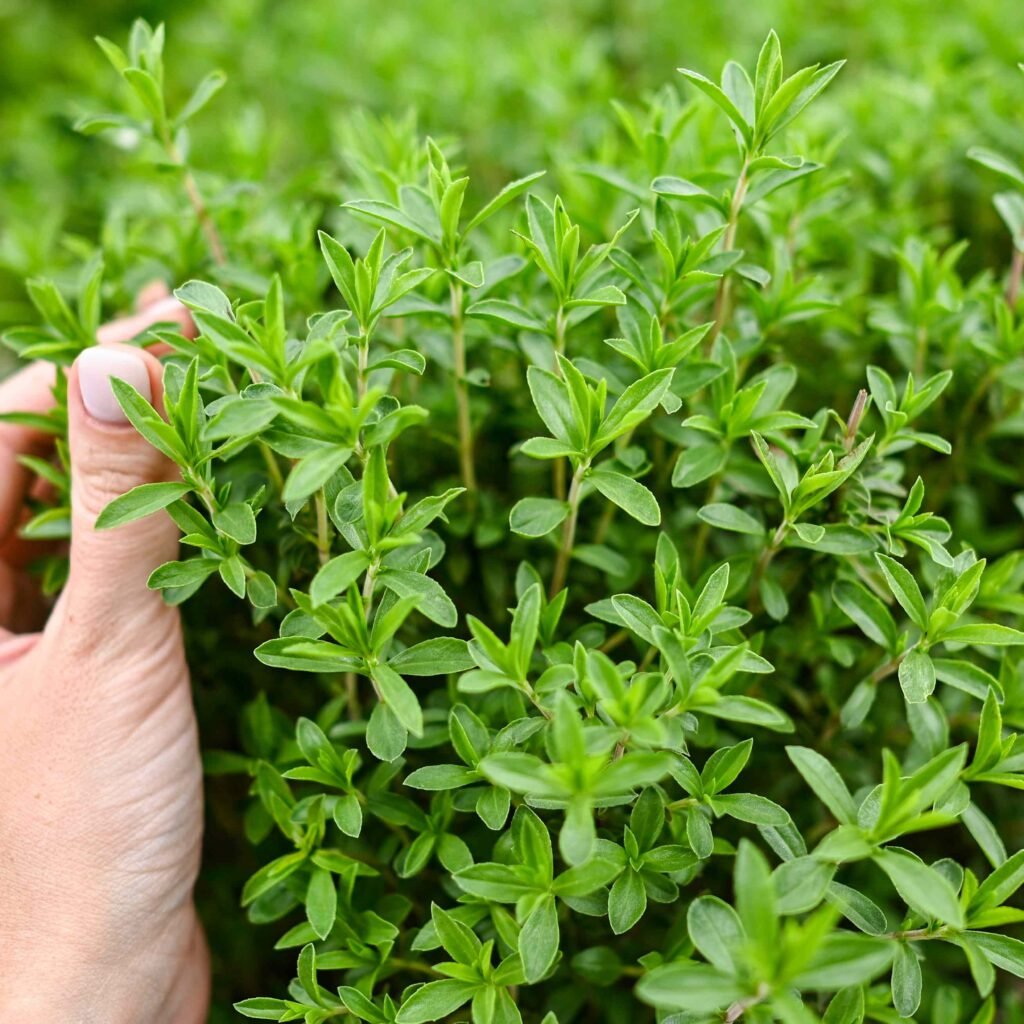
- Harvest thyme in small amounts as needed for cooking to retain maximum flavor.
- Wash gently under cool water and pat dry.
- Use fresh leaves within a few days to enjoy their intense aroma.
Tip: Store fresh thyme in the refrigerator wrapped loosely in a damp paper towel or in a small container to extend freshness.
8. Harvesting for Drying
Drying thyme is a popular way to preserve its aroma for year-round use:
- Harvest full stems during mid-morning when essential oils are concentrated.
- Tie small bundles with string and hang upside down in a warm, dry, well-ventilated area.
- Once completely dry, strip leaves from stems and store in airtight containers away from light.
Proper drying preserves both flavor and aroma, making thyme ideal for winter cooking.
9. Harvesting for Freezing
- Wash and pat dry the stems.
- Chop leaves if desired and freeze in ice cube trays with water or olive oil.
- Transfer frozen cubes to airtight freezer bags for long-term use.
Freezing retains much of the flavor and aroma, especially when fresh thyme isn’t available.
10. Maintaining Plant Health Post-Harvest
After harvesting, it’s important to care for the thyme plant to ensure ongoing productivity:
- Watering: Keep soil moderately moist but avoid overwatering.
- Pruning: Lightly trim remaining stems to encourage new growth.
- Fertilizing: Feed with a balanced fertilizer in spring and early summer if needed.
- Pest control: Monitor for aphids or spider mites; natural sprays like neem oil work well.
Healthy plants produce more aromatic leaves and remain productive for years.
11. Common Mistakes to Avoid
- Harvesting too late: Leaves after flowering have reduced aroma.
- Overharvesting: Removing more than one-third of the plant weakens it.
- Cutting woody stems: Older stems are less flavorful and do not regenerate quickly.
- Harvesting wet leaves: Moisture dilutes essential oils and encourages mold during drying.
Avoiding these mistakes ensures thyme remains a reliable, flavorful herb.
12. Enhancing Aroma Through Proper Care
Aromatic quality depends not just on timing but also on proper growth conditions:
- Sunlight: Thyme thrives in full sun but tolerates some shade.
- Soil: Well-draining soil with moderate fertility encourages strong essential oil production.
- Pruning: Regular trimming of top stems stimulates lateral growth and maintains plant vigor.
- Stress management: Mild drought stress before harvest can sometimes intensify flavor, but avoid severe dehydration.
Balanced care maximizes the aromatic profile of thyme leaves.
13. Culinary and Medicinal Benefits
Freshly harvested thyme provides numerous benefits:
- Culinary uses: Flavorful addition to soups, stews, roasted vegetables, meat dishes, sauces, and herbal teas.
- Aromatic herbs: Releases pleasant fragrance that enhances cooking environments.
- Medicinal properties: Antimicrobial, antioxidant, and anti-inflammatory benefits; used in teas and home remedies for respiratory issues and digestion.
Harvesting at peak aroma ensures maximum flavor and health benefits.
14. Final Thoughts
Thyme is a versatile, aromatic herb that rewards careful cultivation and timely harvest. By understanding growth stages, selecting tender stems, and harvesting before or during flowering, gardeners can enjoy maximum aroma and flavor. Proper harvesting techniques, combined with ongoing plant care, ensure a lush, productive thyme plant that provides fresh leaves for cooking, drying, and preservation throughout the year.
Key takeaways:
- Harvest in mid-morning when essential oils are concentrated.
- Focus on top, tender stems just before flowering.
- Limit harvest to one-third of the plant at a time.
- Use appropriate techniques for fresh, dried, or frozen thyme.
- Maintain plant health with proper soil, water, pruning, and pest management.
With careful attention to timing and technique, thyme can become a perennial source of fresh, aromatic flavor, elevating both your culinary creations and indoor herb garden.
